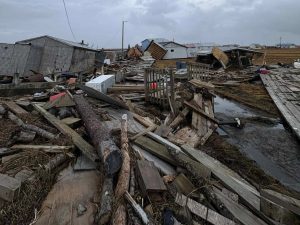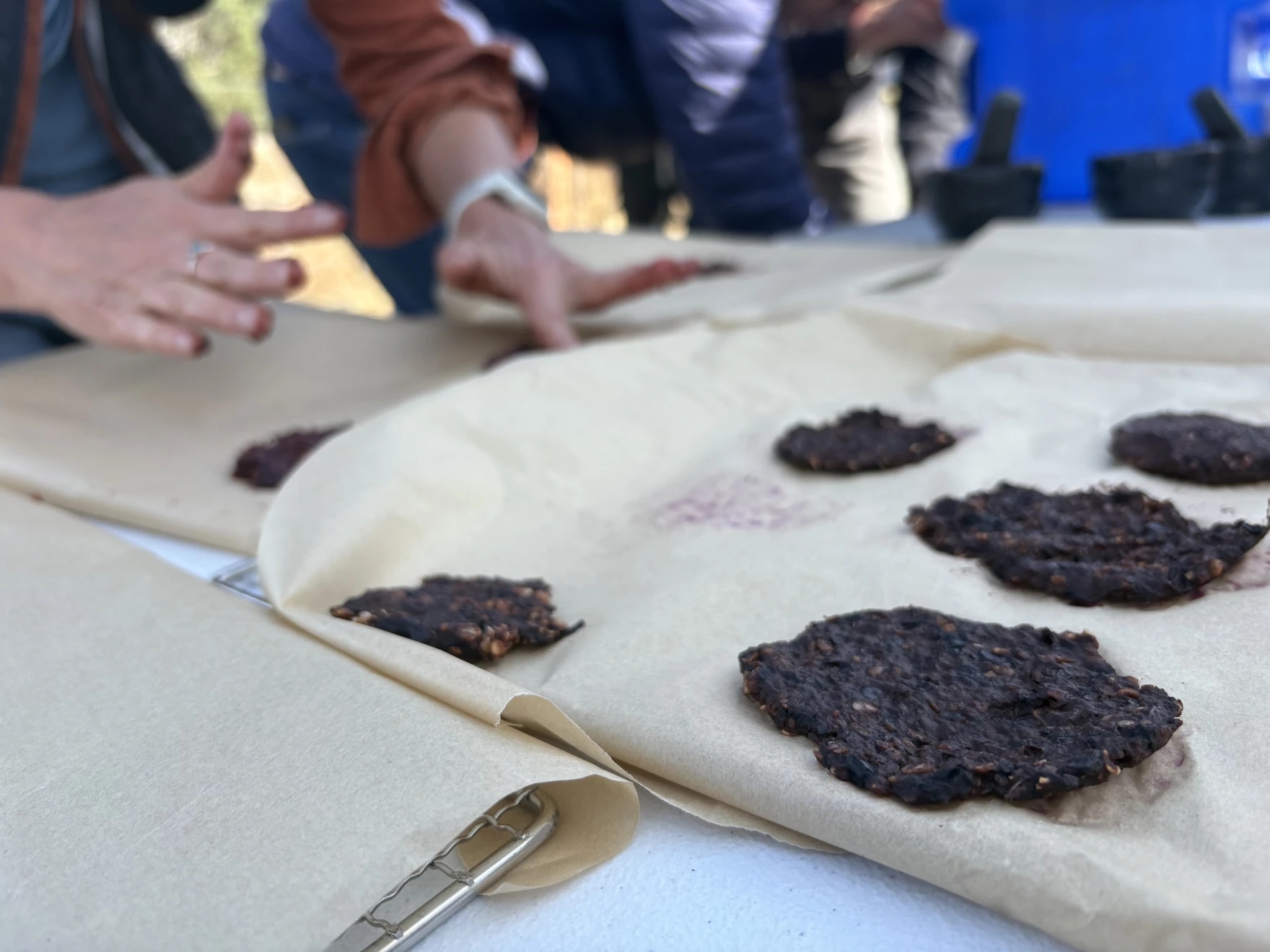Friday, October 17, 2025
Description

Photo: Debris sits in piles in Kwigillingok after the remnants of Typhoon Halong brought widespread devastation to the region. (Brea Paul)
Searches are ongoing for two people missing from a western Alaska village after remnants of Typhoon Halong left one dead and much of the region devastated by high winds and flooding, but large-scale search and rescue efforts are largely on hold pending new information.
The U.S. Coast Guard, Alaska State Troopers, and Alaska National Guard say they were unable to locate a floating house and its occupants before they suspended their active search Monday night.
Coast Guard Captain Christopher Culpepper says the search covered dozens of square miles around the village of Kwigillingok using helicopters, planes, drones, and more.
“Suspending an active search is always a tough decision to make, and it is especially difficult in this situation where the Kwigillingok community is already suffering so much,”
Alaska State Troopers identified the missing people as 71-year-old Vernon Pavil and 41-year-old Chester Kashatok and said they had found the body of 67-year-old Ella Mae Kashatok.
All three lived in the hard-hit village of Kwigillingok and members of the same family.
Brea Paul knew them well. She says she saw their house floating off its foundation as floodwaters rose on Sunday.
“They were the most kindest people I’ve ever met. They didn’t have much, but they always, always had a positive mindset and they always greeted anyone — they welcomed everyone to their home. They deserve to be searched (for). Their names deserve to be heard.”
A mass evacuation is underway for the communities of Kipnuk and Kwigillingok, where a thousand people were sheltering in schools after Sunday’s storm.
On Wednesday and Thursday, hundreds of evacuees boarded planes bound for Anchorage at the Alaska Army National Guard hangar in Bethel.
The city of Anchorage is preparing to welcome up to 2,000 people displaced by the catastrophic storm.

Handmade chokecherry patties dry on parchment paper during a workshop at the Wind River Tribal Conservation Summit. (Photo: Hannah Habermann / Wyoming Public Media)
Community members in Wyoming spent Indigenous Peoples Day to learn and build community at the Wind River Tribal Conservation Summit, as Wyoming Public Radio’s Hannah Habermann reports.
The event was put on by the Wind River Tribal Buffalo Initiative and the Wyoming Outdoor Council Tribal Conservation Team – and included a full schedule of sessions focused on Indigenous conservation, traditional ecological knowledge, and reciprocal relationship.
One of the workshops invited attendees to roll up their sleeves and try their hand at making chokecherry patties.
Before the group got to work, Northern Arapaho two-spirit tribal member Big Wind Carpenter passed around a bag full of the maroon-colored fruit to sample.
“ For the Arapaho people, this is like the best berry of all. It has cultural properties, it has spiritual properties. We use the chokecherry in our ceremonies and it provided sustenance for our people for a long time.”
A person wearing a colorful neck-scarf and a black vest holds a bag of chokecherries and talks. Behind them is a blue sky with feathered clouds and the tops of a few trees.
Carpenter works as a tribal engagement coordinator at the Wyoming Outdoor Council and shared that it’s becoming harder and harder to find chokecherries and other traditional medicines on the reservation.
On top of that, they said making chokecherry patties in particular is becoming more infrequent.
“ It’s important that we continue this tradition because it’s becoming lost as we’ve had freezers and whatnot. A lot of people are just freezing the chokecherries and then discarding the seeds, but the seed is crucial to carrying on that tradition.”
With mortar and pestle in hand, attendees tossed in a handful of chokecherries and got to grinding to make what Carpenter called the “original energy bar.”
The goal: to make the pits as small as possible, and pummel until the mixture started smelling nutty and turned purple.
Two hands hold a mortal and pestle just above the straw covered ground, with ground-up chokecherries inside.
“Inside the pit there’s a nut, and inside the nut are the fatty acids, right? On the exterior of that is this precursor to cyanide, essentially,” they said. “Macerating it is what creates that smell. You get hints of vanilla and all these things, the more you just keep going.”
A young woman in a sweater stands outside in front of a table with chokecherry patties on drying racks. Behind her is a tepee, with another tepee and tables in the background.
Tribal Buffalo Initiative this summer and is majoring in Outdoor Education and Indigenous Studies at Central Wyoming College.
After grinding, the next step was to transfer and spread the paste onto a brown piece of paper to dry into a hardened, flat circle.
Central Wyoming College student and event volunteer Summeri Bass helped people with the transfer process.
“You could tell there’s some people very determined in their patty making and I’m really enjoying the effort,” she laughed. “I like how someone said, ‘Don’t even feel bad about how it looks. You are just doing it right now and you’re just getting in there.’”
After the day of workshops and speakers, more people arrived to celebrate the third annual Buffalo Bash: a night of music, food, and a sunset tour of the Wind River Tribal Buffalo Initiative headquarters.
Get National Native News delivered to your inbox daily. Sign up for our daily newsletter today.
Check out the latest episode of Native America Calling
Friday, October 17, 2025 — Native in the Spotlight: Cannupa Hanska Lugar





